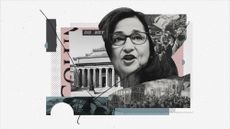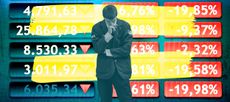The time bomb hidden in your investment portfolio
Do you really know what's in your ETP?


A primary suspect has been identified in the stock market's two massive dives last week: the short volatility trade.
Recently, stock traders have enjoyed an unusual set of "goldilocks" conditions: Strong and steady returns amid perpetually low interest rates. Short volatility trades are basically a financial bet this would continue unabated. But when some unusual wage data caused panic earlier this month, it set off a self-reinforcing spiral: Every loss drove volatility higher, causing yet more losses.
But the reason these trades did so much damage was that they'd become quite common among investors.
Subscribe to The Week
Escape your echo chamber. Get the facts behind the news, plus analysis from multiple perspectives.

Sign up for The Week's Free Newsletters
From our morning news briefing to a weekly Good News Newsletter, get the best of The Week delivered directly to your inbox.
From our morning news briefing to a weekly Good News Newsletter, get the best of The Week delivered directly to your inbox.
How did that happen?
That story begins with something you're probably familiar with, if you have any investment portfolio at all: An exchange traded fund, or ETF. The most common ETF is the humble index fund: passive vehicles that just invest your money proportional to some index, like the S&P 500. They're the gold standard for responsible, low-risk investment in the stock market.
But index funds aren't the only kind of ETF. Furthermore, ETFs fall under a broader category of financial instruments called exchange traded products, or ETPs. They all function in ways fundamentally similar to index funds. But some add on extra bells and whistles, like derivatives and other bets that often involve significant amounts of debt. The idea is to make a more attractive financial product by cranking up the possible returns over what you'd get with a regular index fund.
It also makes these ETPs more complicated, and thus more risky.
"Inverse and leveraged exchange-traded products are not ETFs, and they don't perform like ETFs under stress," said BlackRock, a major financial firm, and one of the three main players in the American ETF industry.
"They're motorcycles, not minivans," Sylvia Jablonski, who leads the capital markets division at Direxion Investments and deals in these sorts of products, told Bloomberg. "I'd be the first person to tell a retail investor who's not comfortable with leverage: Don't use our products."
This is where short volatility trades re-enter our story. They're based around the VIX, also known as Wall Street's "fear gauge." It measures expectations that stocks will rise or fall dramatically in the future. It's been at extreme lows for years, and short volatility trades functioned as bets that it would stay low — generally for a set period, like one month. There are more than 30 financial products out there for doing this. One of the most popular was Credit Suisse's Velocity Shares Daily Inverse VIX Short Term ETN — or XIV, for short.
While they lack the sobriety of standard ETFs and index funds, the XIV and other juiced-up ETPs aren't that much harder to buy. And a lot of investors may not have fully appreciated the difference.
Last year, ETPs linked in some way to the fear gauge hit daily trading volumes bigger than that of JPMorgan Chase or Google stock. In November, inverse ETPs (like the XIV) or leveraged ETPs did more volume than Apple. Short volatility trades specifically increased more than 1,000 percent over the last five years. The value of the XIV alone jumped 500 percent in the last two years, pushing $1.8 billion on wagers the markets would stay calm.
The markets did not cooperate.
Last Monday, the fear gauge jumped 100 percent — its biggest daily move ever. The trading price of the XIV collapsed from $99 to $7. Another major short volatility trade, the ProShares Short VIX Short Term Futures (SVXY), fell just as hard. Because many of these trades were built on leverage, investors had to buy up millions worth of VIX futures. To get the money, they had to shed huge amounts of stocks and bonds. Both drove the fear gauge still higher. Throw in plenty of instant, computerized trading, and you had a recipe for a massive negative feedback loop. In two days, the XIV and the SVXY's combined value plummeted from $3 billion to $150 million.
In the aftermath, Credit Suisse announced it will scuttle the XIV in a few days. Blackrock is calling for regulators to create a labeling system that makes clear the difference between short volatility trades and other leveraged or inverse ETPs, and your run-of-the-mill ETFs and index funds. Pressure is growing for government regulators to step in and figure out what happened.
In fact, the Financial Industry Regulatory Authority — Wall Street's private self-regulator — has already issued warnings about these products. It also recently ordered Wells Fargo to pay investors $3.4 million for improperly marketing them. There are even accusations floating around that the fear gauge was manipulated.
"What happened is almost unprecedented. They pretty much have to investigate with gyrations this large," Robert Whaley, the Vanderbilt University professor credited with creating the fear gauge, told the Financial Times. "But the investigation should go more broadly and not just look at XIV. They should look at the inverse and leveraged products more broadly."
"We're putting sophisticated trading tools in the hands of retail investors," he says. "We have to think about why we are approving these things."
Last week's stock market rout had no discernable effect on economic fundamentals like job creation or wage growth. When (or if) another juiced-up ETP sets off a panic, it seems extremely unlikely that it could cause a recession. Thus, you could certainly write this off as only a problem for individual investors. "We provide very clear disclosure about how these products work," insisted Jablonski, whose company specializes in these sorts of leveraged ETPs, though none linked to the VIX. "It democratizes the ability to get leverage."
But Social Security just isn't enough for a decent retirement, and old-fashioned job pensions have gone the way of the dodo. These days, the financial markets are the only game in town for anyone with any surplus cash to save. Retail investors look for stability, but they'll be tempted by better returns, and too-good-to-be-true deals that promise both. Despite being decimated by the recent panic, money is already creeping back into other short volatility trades like the SVXY.
Nor are these the only weird trades tucked away in these products. Bloomberg estimated that 20 percent of all American ETFs involve some kind of derivative.
There may still be other time bombs out there.
Create an account with the same email registered to your subscription to unlock access.
Sign up for Today's Best Articles in your inbox
A free daily email with the biggest news stories of the day – and the best features from TheWeek.com
Jeff Spross was the economics and business correspondent at TheWeek.com. He was previously a reporter at ThinkProgress.
-
 Cicada-geddon: the fungus that controls insects like 'zombies'
Cicada-geddon: the fungus that controls insects like 'zombies'Under The Radar Expert says bugs will develop 'hypersexualisation' despite their genitals falling off
By Chas Newkey-Burden, The Week UK Published
-
 'Voters know Biden and Trump all too well'
'Voters know Biden and Trump all too well'Instant Opinion Opinion, comment and editorials of the day
By Harold Maass, The Week US Published
-
 Is the Gaza war tearing US university campuses apart?
Is the Gaza war tearing US university campuses apart?Today's Big Question Protests at Columbia University, other institutions, pit free speech against student safety
By Joel Mathis, The Week US Published
-
 The pros and cons of noncompete agreements
The pros and cons of noncompete agreementsThe Explainer The FTC wants to ban companies from binding their employees with noncompete agreements. Who would this benefit, and who would it hurt?
By Peter Weber Published
-
 What experts are saying about the economy's surprise contraction
What experts are saying about the economy's surprise contractionThe Explainer The sharpest opinions on the debate from around the web
By Brendan Morrow Published
-
 The death of cities was greatly exaggerated
The death of cities was greatly exaggeratedThe Explainer Why the pandemic predictions about urban flight were wrong
By David Faris Published
-
 The housing crisis is here
The housing crisis is hereThe Explainer As the pandemic takes its toll, renters face eviction even as buyers are bidding higher
By The Week Staff Published
-
 How to be an ally to marginalized coworkers
How to be an ally to marginalized coworkersThe Explainer Show up for your colleagues by showing that you see them and their struggles
By Tonya Russell Published
-
 What the stock market knows
What the stock market knowsThe Explainer Publicly traded companies are going to wallop small businesses
By Noah Millman Published
-
 Can the government save small businesses?
Can the government save small businesses?The Explainer Many are fighting for a fair share of the coronavirus rescue package
By The Week Staff Published
-
 How the oil crash could turn into a much bigger economic shock
How the oil crash could turn into a much bigger economic shockThe Explainer This could be a huge problem for the entire economy
By Jeff Spross Published